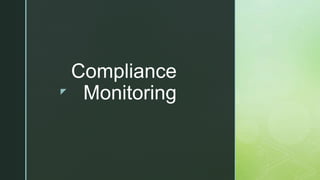
Compliance Monitoring.pptx
- 2. z What is Compliance Monitoring? Compliance monitoring refers to the process of overseeing business operations to ensure that organizations are aligned with industry and other regulatory mandates. Cybersecurity compliance monitoring begins with evaluating which regulations apply to your organization directly, as well as determining what compliance with these regulations looks like.
- 3. z Purpose of Compliance Monitoring The purpose of compliance monitoring is to ensure your organization is meeting various standards and regulations on an ongoing basis. It can also help identify any regulatory gaps within your cybersecurity controls and inform the changes you can make to your cybersecurity framework to better maintain adherence with applicable regulations.
- 4. z Creating a Compliance Monitoring Plan Once an audit is complete, you can then begin creating a compliance monitoring plan. A compliance plan helps your company to follow the laws, regulations, and rules that govern your industry. When creating a compliance monitoring plan, you should aim to address all the risks identified in the audit stage, however, risks that pose the greatest threat to your organization should be prioritized. Once you have identified priority risks to monitor, you then need to decide how you are going to implement the monitoring program.
- 5. z Certain elements that every compliance monitoring plan should have: An agreed-upon scope and strategy. A schedule for regular reviewing of all policies and procedures. Standard tools and reporting templates. Systems for reporting. Training and improvement. Consequences for failing to improve or complete training.
- 6. z Compliance Monitoring Strategy (CMS) Compliance Monitoring Strategy (CMS) outlines how states should evaluate the compliance status of a facility and the frequency of evaluations. Data associated with compliance activities is uploaded to the EPA by the DAQ on a monthly basis. This data can be viewed at EPA’s Enforcement and Compliance History Online (ECHO).
- 7. z Why Is Compliance Monitoring So Important? At a basic level, monitoring ensures that your organization’s operations are happening and working as they should. More broadly, it can identify any areas of noncompliance, whether with internal policies or external regulations ‘ and whether accidental or intentional. Compliance monitoring also helps healthcare organizations identify problems and find solutions before a government agency finds them. By regularly monitoring and auditing your compliance policies, you can spot errors and problems that require additional training and professional development.
- 8. z Compliance Monitoring Systems There are several moving parts to a compliance monitoring system, including policy reviews, external audits, internal monitoring, and even policy and compliance management software.
- 9. z Thank you